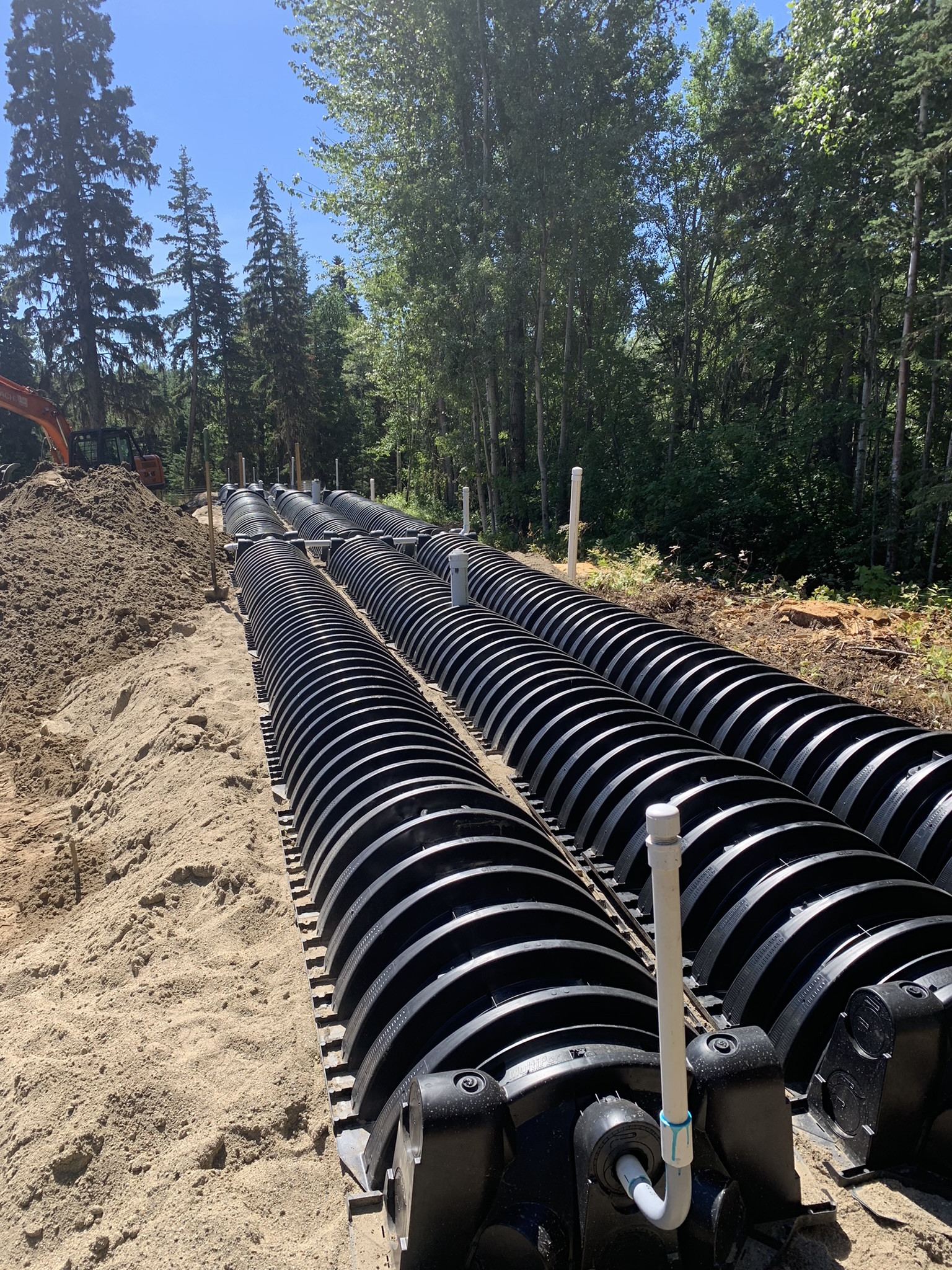
Resources, Links & FAQ
FAQ
Who is an Authorized Person (AP)?
An Authorized Person (AP) is either a Professional or a Registered Onsite Wastewater Practitioner (ROWP).
What is a Professional?
A professional is someone who has professional status and is competent in the area of sewerage system design.
The BC Association of Professional Engineers and Geoscientists also maintains a list of professionals.
ROWP: What kinds of septic systems do they design and/or build?
To meet the requirements of the Sewerage System Regulation, ASTTBC certifies Authorized Persons as Registered Onsite Wastewater Practitioners (ROWP).
Allowable scopes of practice:
- Installer
- Maintenance
- Provider
- Planner
- Private Inspector
ROWPs may be certified in one or more categories.
How can I find an ROWP in my area?
To find a ROWP go to ASTTBC. https://owrp.asttbc.org/
When do you need a septic system?
In BC, you need an onsite septic system unless there is available municipal or community servicing available for sewerage.
Who can design a septic system?
BC Law…You Need an Authorized Person
A homeowner in British Columbia is not legally allowed to design, construct, repair OR conduct maintenance on a septic system.
Any work performed on a system must be done under the supervision of a Professional Engineer or by a certified ROWP (Registered Onsite Wastewater Practitioner).
What is Standard Practice?
The Sewerage System Regulation (Part 1) defines standard Practice: ” Standard practice means a method of constructing and maintaining a septic system that will ensure that the system does not cause, or contribute to, a health hazard.”
The Regulation relies upon the Authorized Person to confirm that the septic system has been planned and constructed in accordance with standard practice.
What is the Standard Practice Manual (SPM)?
The Sewerage System Regulation Act identifies the SPM as a source of standard practice.
What are the design criteria for constructing a septic system?
All Authorized Persons (AP’s) are required to construct any septic system in accordance with standard practice. The BC Ministry of Health maintains the BC Standard Practice Manual (SPM) which is one standard practice. Sewerage System Standard Practice Manual
What are the design criteria for constructing a septic system?
All Authorized Persons (AP’s) are required to construct any septic system in accordance with standard practice. The BC Ministry of Health maintains the BC Standard Practice Manual (SPM) which is one standard practice. Sewerage System Standard Practice Manual
What information does the Authorized Person (AP) need to submit to the Health Authority before construction?
Prior to constructing any septic system an AP must “file” information with the health authority. This information submission includes a filing form (Sewerage System Record), soils information, design rationale, plans and specification of the system, a property site plan, any applicable covenants, easements or hydrogeological reports.
The filing form includes information about the owner, AP, property location, site conditions, type of system being constructed and the type of structure the system will be serving.
I am changing the use of my building and I am not sure if I have to upgrade the system?
If there is a potential increase in the daily flow you likely have to update the system. The Sewerage System Regulation requires the owner of a building to ensure the system is designed to accommodate sewage from that building.
The need to upgrade the septic system can result from change of building size (increased square footage or increase in number of bedrooms), change in sewage flow (adding more seats to a restaurant) or changing sewage strength (corner store changing to a restaurant).
If the change to the building requires a building permit the Building Inspection Authority may require you to obtain a report from an AP to assess the system’s capacity to accommodate the building changes. If you are making changing to a commercial establishment such as a restaurant the local Environmental Health Officer may require you to obtain a report from an AP to assess the system’s capacity to accommodate the building changes. If you are in doubt you can contact an AP or contact an Environmental Health Officer.
What are the steps for obtaining an onsite septic system in BC
A “Sewerage System Record” has to be submitted to the health authority; along with the site assessment results, design rationale and design drawings, and filing fee.
Once accepted, the septic system can be constructed as per the design.
During construction, onsite inspections are required by the authorized person. If there are no deficiencies or problems with the construction and the authorized person (planner) is satisfied, another final submission is required to the health authority by the planner. This includes:
Letter of Certification
Operation & Maintenance Manual
As-built drawings.
Once the “Letter of Certification” has been signed-off and the documentation has been submitted to the health authority and a copy supplied to the owner, the onsite sewerage system is now a legal and certified system. The system can now be commissioned for use.
How do holding tank system permit applications work?
In BC, holding tanks are a permitted process which is different than a submission for an onsite sewerage system.
The health authority has the authority to accept or deny a holding tank permit application based upon their approval process.
According to Northern Health:
“A holding tank is a large watertight vessel that allows for the collection and temporary storage of sewage effluent from a residence or building for future removal and transport to an approved treatment and disposal sight.”
What you need to know
No one can design, install, repair, or alter a holding tank without an approved permit
Permits are issued by the health authority in your area
Each application is considered on a case by case basis and has to meet specific criteria
Applications must be prepared AND provided by an authorized person
A holding tank becomes legal and certified and ready for use once the “Holding Tank Record of Installation” has been signed off by the approving officer from the health authority
What are the steps for obtaining an onsite septic system in BC
A “Sewerage System Record” has to be submitted to the health authority; along with the site assessment results, design rationale and design drawings, and filing fee.
Once accepted, the septic system can be constructed as per the design.
During construction, onsite inspections are required by the authorized person. If there are no deficiencies or problems with the construction and the authorized person (planner) is satisfied, another final submission is required to the health authority by the planner. This includes:
- Letter of Certification
- Operation & Maintenance Manual
- As-built drawings.
Once the “Letter of Certification” has been signed-off and the documentation has been submitted to the health authority and a copy supplied to the owner, the onsite sewerage system is now a legal and certified system. The system can now be commissioned for use.
How does a holding tank permit application work?
In BC, holding Tanks are a permitted process which is different than a submission for an onsite sewerage system.
The health authority has the authority to accept or deny a holding tank permit application based upon their approval process.
According to Northern Health:
“A holding tank is a large watertight vessel that allows for the collection and temporary storage of sewage effluent from a residence or building for future removal and transport to an approved treatment and disposal sight.”
What you need to know
No one can design, install, repair, or alter a holding tank without an approved permit
Permits are issued by the health authority in your area
Each application is considered on a case by case basis and has to meet specific criteria
Applications must be prepared AND provided by an authorized person
A holding tank becomes legal and certified and ready for use once the “Holding Tank Record of Installation” has been signed off by the approving officer from the health authority
What is an onsite suitability report?
An Onsite Septic Suitability Report is one of the conditions needed to be satisfied for the subdivision approval process.
An authorized person is required to do a site evaluation of the:
- soils
- water table conditions
- available space of each proposed lot
In addition, a summary of the site assessment results in a report, along with a site plan is required for submission to the subdivision approving officer at the Ministry of Transportation.
Can my septic system be upgraded or repaired?
Whether or not your system can be upgraded to serve a new or expanded use depends on the situation.
Factors that determine this are…
Whether or not the system meets the standards of the day for the proposed new daily design flow
If the system is functioning to current standard practice and that the system is NOT contributing to an environment or health issue
the age of the system
Availability of required documentation.For older systems, the documentation needed is the “Operation to Construction” AND “The Authorization to Operate”.
Resources & Links
Northern Health Authority
Sewerage and subdivision
Northern Health – Sewerage System Forms and Information
ASTTBC – Find A Professional
List of certified Registered Onsite Wastewater Practitioners (ROWP’s) in good standing with ASTTBC
https://owrp.asttbc.org/rowp-finder/
WCOWMA
Western Canada Onsite Wastewater Management Association is the not for profit organization established to educate, train and certify industry professionals in western Canada. The association engages its member installers, septage haulers, suppliers, municipalities, and provincial government to arrive at sound practices that strenghten the industry, and ensure safe and effective septic management for all western Canada.
www.wcowma.com
Sewerage System Regulation
The BC Regulation applies to all residential on-site septic systems
http://www.bclaws.ca/
Standard Practice Manual
The manual provides a comprehensive set of provisions that support the design, installation and maintenance of composting toilet-based sewerage systems, and aligns with the Sewerage System Regulation, Environmental Management Act, Municipal Wastewater Regulation, and BC Building Code.
Interior Health Authority
How to locate a sewerage record, Information on the subdivision of land, holding tank permits, onsite systems
Interior Health – Sewerage Records. Subdivisions, Holding Tank Permits, Onsite Septic
Fraser Fort George Regional District
How to obtain a building permit and occupancy permit
Fraser Fort George Regional Districty – Building and Occupancy Permits
Cariboo Regional District
Building Inspection, application forms, required permits and fees
Cariboo Regional District – Septic Systems Forms, Permits, Inspections
BCOSSA
BC Onsite Sewerage System Association that has developed and delivered mandated educational programs to it’s onsite wastewater practitioners
